App sprawl is increasingly plaguing modern enterprise IT. An alarming 67% of SMB marketers in Capterra's study estimate that one-third of their companies’ tech stacks remain unused. This surplus of unused apps drains budgets, hampers productivity, and creates risk without return.
Consolidation is one of the tried-and-tested tactics to effectively trim down on these unnecessary apps: more than 37% of respondents from the same study opted to replace standalone tools with multifunctional software suites. If you are also contemplating the move to one vendor, this information is be insightful for you.
As a data transfer tool, we’ve facilitated numerous consolidation cases. To help you make the right decision, we'll delve into the pros and cons of both standalone solutions and suites. Additionally, we’ve curated a list of reliable suite providers, and outlined your data transfer options.
TL;DR: Migration to a Single Vendor Suite for Optimized Operations
Modern enterprise IT is plagued by app sprawl, with 67% of SMB marketers reporting unused tech stacks. Consolidation can trim these excess apps, saving budgets and boosting productivity. A Capterra study found 37% of businesses replaced standalone tools with multifunctional software suites.
Key Comparisons: Multiple Vendors vs. Single Vendor Suites
- Innovation Diversity:
- Different Vendors: Tailored tools for specific needs.
- Single Vendor: Consistent interface, but not always the best fit for every department.
- Data Silos:
- Different Vendors: Scattered data disrupts efficiency.
- Single Vendor: Centralized data enhances productivity.
- Integration:
- Different Vendors: Custom integrations needed, increasing complexity.
- Single Vendor: Seamless communication within the suite.
- Training and Onboarding:
- Different Vendors: High training costs due to varied interfaces.
- Single Vendor: Consistent UX reduces training time.
- Data Security:
- Different Vendors: Increased risk with multiple entry points.
- Single Vendor: Uniform security measures.
- Maintenance and Support:
- Different Vendors: Fragmented support slows issue resolution.
- Single Vendor: Unified support standards.
- Cost Implications:
- Different Vendors: Potential savings from separate negotiations, but higher integration and training costs.
- Single Vendor: Bundled packages save costs, but may include unnecessary tools.
- Service Continuity:
- Different Vendors: Multiple licenses to manage.
- Single Vendor: Easier license management, but risk if vendor issues arise.
Top Software Suite Vendors:
- Zendesk: Comprehensive customer engagement suite.
- Freshworks: Affordable with free plans, includes ITSM solution.
- Zoho: Wide range of customizable business applications.
- HubSpot: Free versions, ideal for small businesses.
- Salesforce: Best for large enterprises.
- Atlassian: Excellent for software development collaboration.
Migration Made Easy: Help Desk Migration simplifies the transfer of customer support data, ensuring data structure integrity, uninterrupted processes, and data privacy. Opt for self-managed or Concierge migration for a hassle-free vendor switch.
Consolidating to a unified suite can streamline operations, enhance efficiency, reduce errors, and lower IT expenses, with Help Desk Migration ensuring a seamless transition.
Multiple Tools from Different Vendors vs. Consolidation: Key Considerations Before Switching the Vendor
Shifting data from one software to the other is an arduous task on its own. But with small and medium-sized businesses juggling an average of 20 software accounts, transferring data to a unified suite is a truly significant undertaking. That’s why it’s important to weigh up the options before making a vendor switch.
We’ve drawn up comparisons between using diverse vendors and embracing a single vendor suite across eight key criteria.
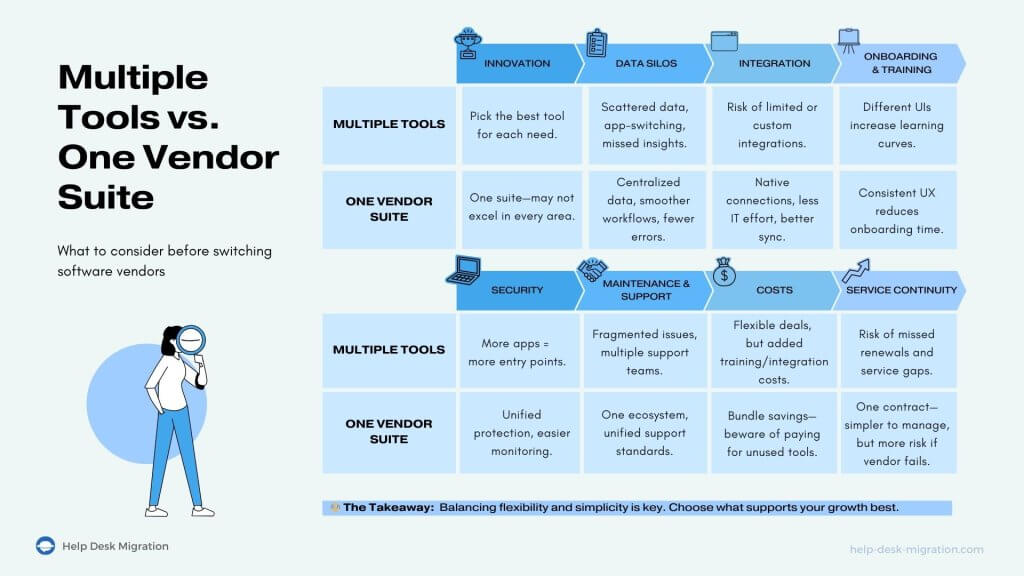
Innovation diversity
| Different vendors | Single vendor |
| Selecting tools individually allows businesses to pick the best solution for each specific need or department. For example, your customer support team might consider using Zendesk—a help desk solution known for its comprehensive feature set and unparalleled AI capabilities. At the same time, Jira Service Management might meet your IT department’s requirements. Finally, your sales team might prefer Salesforce for their CRM needs. | While a suite provider may offer solutions for each department, not every offering will necessarily excel in its category. For instance, while Zendesk may impress your customer support team, the sales department might not be as satisfied with Zendesk Sell. |
Data silos
| Different vendors | Single vendor |
| Scattered data across multiple applications disrupts operational efficiency, forcing employees into a cycle of app-switching. The differing interfaces, inconsistent communication between tools, and an increased error rate caused by copying and pasting data between the applications all negatively impact performance. A Gartner survey found that 36% of its respondents missed critical data due to this fragmentation. Additionally, fragmented sources make it challenging to integrate data for comprehensive insights and to automate workflows across functions. | Relying on a suite of apps from a single vendor centralizes all your information into a single hub. Meaning there's no need to juggle between various apps to access crucial data for reporting or context-based support. Eliminating the need for repetitive copy-pasting streamlines operations and enhances efficiency across tasks. With most of your essential apps integrated within the same suite, data effortlessly flows between them, ensuring nothing slips through the cracks. This streamlined flow significantly boosts productivity, reduces errors, and empowers you to deliver high-quality, personalized support. |
Integration considerations
| Different vendors | Single vendor |
| While many leading help desk solutions offer APIs for popular business applications—like Zendesk, which integrates with over 1000 third-party software solutions—this isn't a given. There may be sticking points where your chosen applications lack integration, necessitating the development of custom connectors. Creating these demands considerable time and resources, and leads to increased system complexity. Even when integration is possible, there may be restrictions on the volume of data exchanged, creating further constraints. | Software solutions integrated within suites are designed to effortlessly communicate data among themselves. This eliminates the need for your IT department to spend time stitching together disparate systems. Moreover, many offer the convenience of purchasing all the components within a single package. Zoho One, for example, provides access to the full range of Zoho’s solutions. In addition, let’s not forget about data exchange limitations. For example, while HubSpot integrates with Zendesk, Zendesk’s data isn’t automatically incorporated into your HubSpot reports—and vice versa. However, you can set up HubSpot service hub’s reporting function to automatically pull sales data. |
Training and onboarding
| Different vendors | Single vendor |
| Navigating applications from different vendors exposes your employees to inconsistency. With a desk agent now on average using 11 applications (up from six in 2019) to perform their job, relying on multiple vendors can considerably amplify the learning curve for onboarding employees, inflating your training costs. | While applications within a single suite have distinct features, their interfaces and user experiences remain consistent. Consequently, employees familiar with a Zendesk help desk solution will likely grasp the intricacies of another customer service tool from the same vendor, such as a sales tool, much more swiftly. Such familiarity can significantly reduce your training costs. At the same time, suites can be complex in their own right, requiring extensive training across the functions. |
Data security
| Different vendors | Single vendor |
| An astounding 79% of cybersecurity professionals in AppOmni's survey ported experiencing SaaS security incidents in 2022 despite robust protective measures. Meanwhile, the use of applications from multiple vendors can weaken your organization’s security standing. A diverse array of applications provides hackers with numerous entry points into your IT ecosystem, and complicates data tracking by your IT team, heightening the risk of potential leaks. | Managing security is more straightforward within a single suite. First, security protocols and measures can be uniformly applied across the entire ecosystem. Second, the unified structure not only provides your security team with enhanced visibility and control but also simplifies the tracking of information due to centralized data storage. Furthermore, the integrated software suites significantly reduce potential entry points for hackers. |
Maintenance and support
| Different vendors | Single vendor |
| Maintaining too many software solutions can be time-consuming and costly. Integrating old systems, setup difficulties, and guaranteeing data security—each of these steps is resource-intensive. Maintaining the entire ecosystem's functionality is an ongoing challenge: fragmented troubleshooting across various vendors can significantly slow down issue resolution. Plus, you’ll need to engage with multiple support teams, each operating under their own service-level standards. | Applications within a single suite are designed to seamlessly coexist within the same ecosystem, simplifying matters for your IT department. Moreover, app consolidation ensures unified customer support standards: whenever issues arise, you can expect a consistent level of support. This provides a sense of reliability and predictability for your team. At the same time, while your business apps may be designed to coexist, such ecosystems can still be complex. So, it’s advisable to select a vendor that prioritizes simplicity. |
Cost implications
| Different vendors | Single vendor |
| On the one hand, dealing with multiple software vendors allows businesses to negotiate prices and terms separately, potentially leading to cost savings. On the other hand, integration, training, maintenance, and administrative implications require extra budget. | By consolidating help desk and other business tools under the same vendor, businesses can benefit from bundled packages, often leading to significant savings. As highlighted earlier, choosing a unified suite reduces expenses tied to integrations, training, maintenance, and asset management. However, bundled packages might include unnecessary tools, leading to superfluous expenses. It's a common industry observation that many businesses, especially smaller ones, purchase entire suites like Microsoft Office 365 or Adobe Creative Cloud for access to specific tools (such as Word or Photoshop) and do not use the full range of services included in these suites. |
Service continuity
| Different vendors | Single vendor |
| Using multiple business software, inclusing help desk tools, requires monitoring multiple contracts and multiple licenses at the same time. Even a minor oversight can lead to critical services becoming unavailable due to an expired license. | Relying on a single suite alleviates the burden of managing multiple licenses. However, there's a potential risk: if an issue arises on the vendor's end, it could result in the simultaneous loss of access to all business services. |
6 Top Software Suite Vendors to Consider
As shown above, switching to a vendor that offers a unified software suite presents numerous advantages and fewer drawbacks than relying on multiple vendors. However, it's vital to choose a solution that meets your business needs. Otherwise, you risk adding redundant solutions to your stack.
When it comes to selecting a reliable multifunctional software suite, Freshworks, Zendesk, Zoho, HubSpot, Atlassian, and Salesforce are the top vendors. Let's delve deeper into each of these options.
Zendesk
Zendesk is a customer service software company established around a CRM platform and is one of the most comprehensive help desk solutions on the market. Nowadays, Zendesk goes beyond mere help desk management, providing a suite of software solutions catering to various facets of customer engagement.
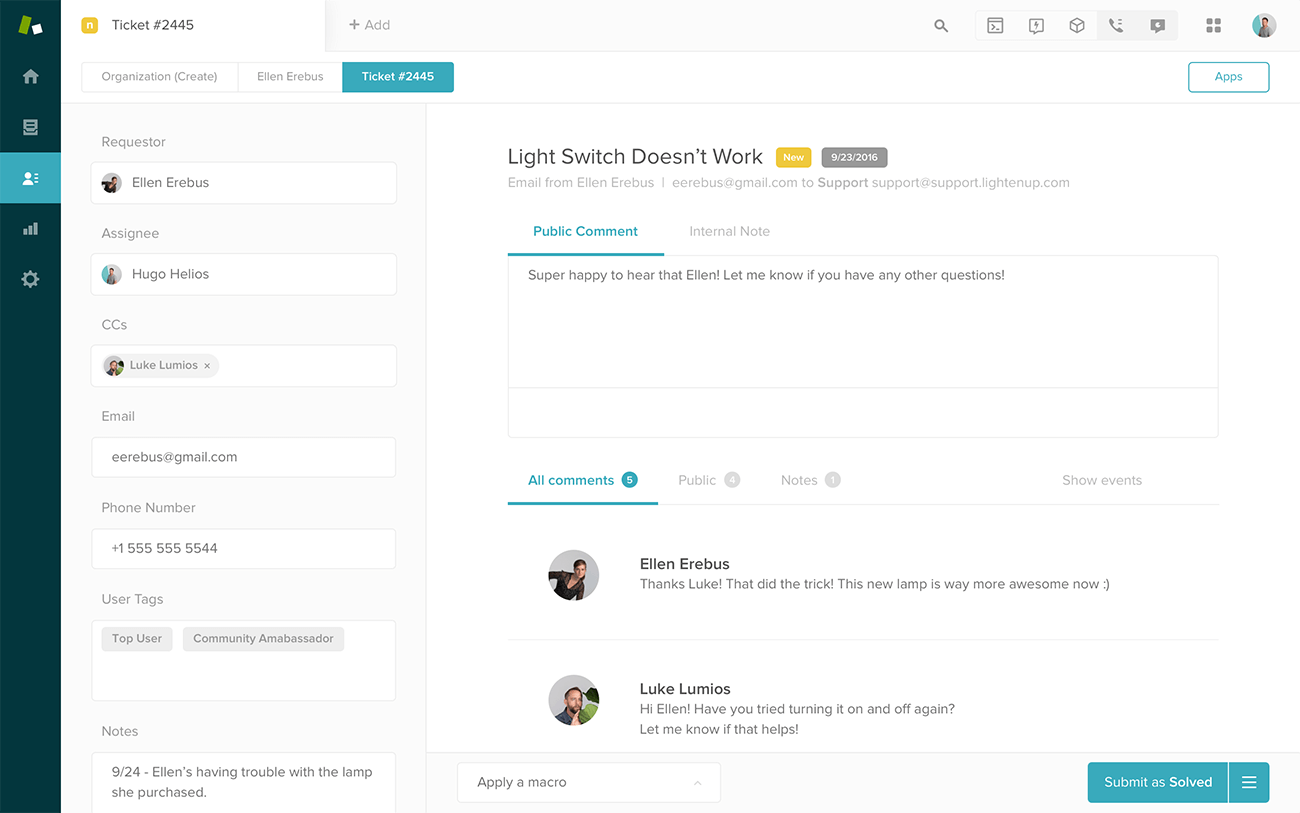
Key products:
- Zendesk Suite is a centralized platform for addressing customer requests coming across various channels. Standing out for its AI capabilities, Zendesk Suite offers a ticketing system, a knowledge base, a live chat, and analytics.
- Zendesk Sell is a sales CRM platform. Designed to streamline sales processes, it comes with features for lead and contact management, pipeline management, sales automation, and reporting.
- Sunshine Platform is a CRM platform that consolidates customer data from various sources, like help desks, other CRM systems, IoT devices, customer support channels, surveys, etc.—making it different from Zendesk Sell, which is designed purely for sales teams. It also comes with open APIs, enabling users to create their own CRM solutions.
Since Zendesk offers extensive analytics capabilities and is geared toward large teams while having no free plans, it’s a perfect fit for large companies looking to enhance and prioritize their customer support efforts.
Now, let's talk migration – a daunting task for even the most seasoned support professionals. Fortunately, Help Desk Migration offers a lifeline with its Business Rules Migration feature. This game-changing solution allows businesses to seamlessly import macros and triggers during the consolidation of their Zendesk help desk instances, saving time, effort, and headaches in the process.
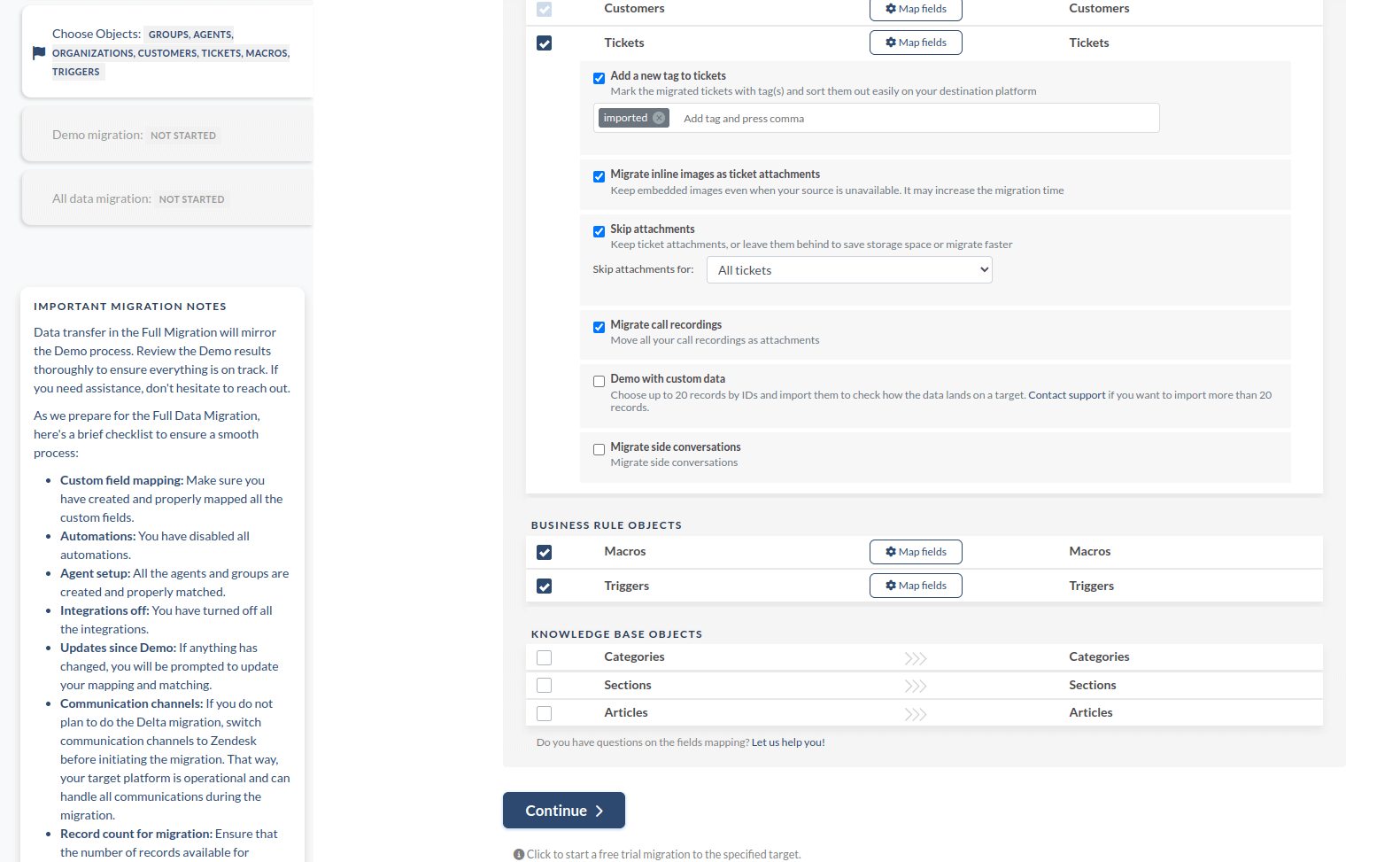
With Help Desk Migration's automated feature, businesses can confidently navigate the migration process, knowing that their macros and triggers will be transferred accurately and efficiently. Say goodbye to manual data wrangling and hello to a smooth transition with Help Desk Migration by your side.
Freshworks
Similar to Zendesk, Freshworks was launched on the basis of a cloud-based help desk management solution, Freshdesk. Today Freshworks Customer Service Suite is known for tools that streamline customer support, IT service management, sales, and marketing.

Key products:
- Freshdesk is an all-in-one help desk management system equipped with ticket management, live chats and chatbots, a knowledge base, automations, reporting, and other features.
- Freshservice is an ITIL-aligned tool designed to tackle internal customer requests and IT issues. It provides features for managing incidents, problems, assets, changes, SLAs, and other aspects of IT service management (ITSM).
- Freshsales is an AI-powered CRM platform for managing prospects, contacts, deals, and sales pipelines. It has features like email integration, automation, analytics, lead scoring, and more.
- Freshchat is a live chat solution for real-time customer engagement across channels. It also comes with AI-powered bots, enabling companies to scale support.
- Freshcaller is a call center solution for sales and customer service teams. It comes with call routing, IVR, call recording, analytics, and other features for seamless voice engagement.
- Freshmarketer is a marketing automation platform with features like conversion rate optimization (CRO), behavioral targeting, heatmaps, funnel analysis, and email marketing automation.
Though Freshworks Customer Service Suite provides solutions that are very similar to Zendesk’s offerings, they are more basic. On the other hand, all except for Freshservice have free subscription packages, making Freshworks a go-to suite for businesses with limited budgets. At the same time, Freshservice is what sets Freshworks apart from Zendesk, HubSpot, and Salesforce. So, if you need an ITSM solution, be sure to add this to your consideration list.
Zoho
In the early 2000s, one network management company pivoted into the SaaS realm with two offerings—a CRM platform and a solution for document management and collaboration. This company is today known as Zoho—a provider of 40+ business applications covering diverse needs across various departments.
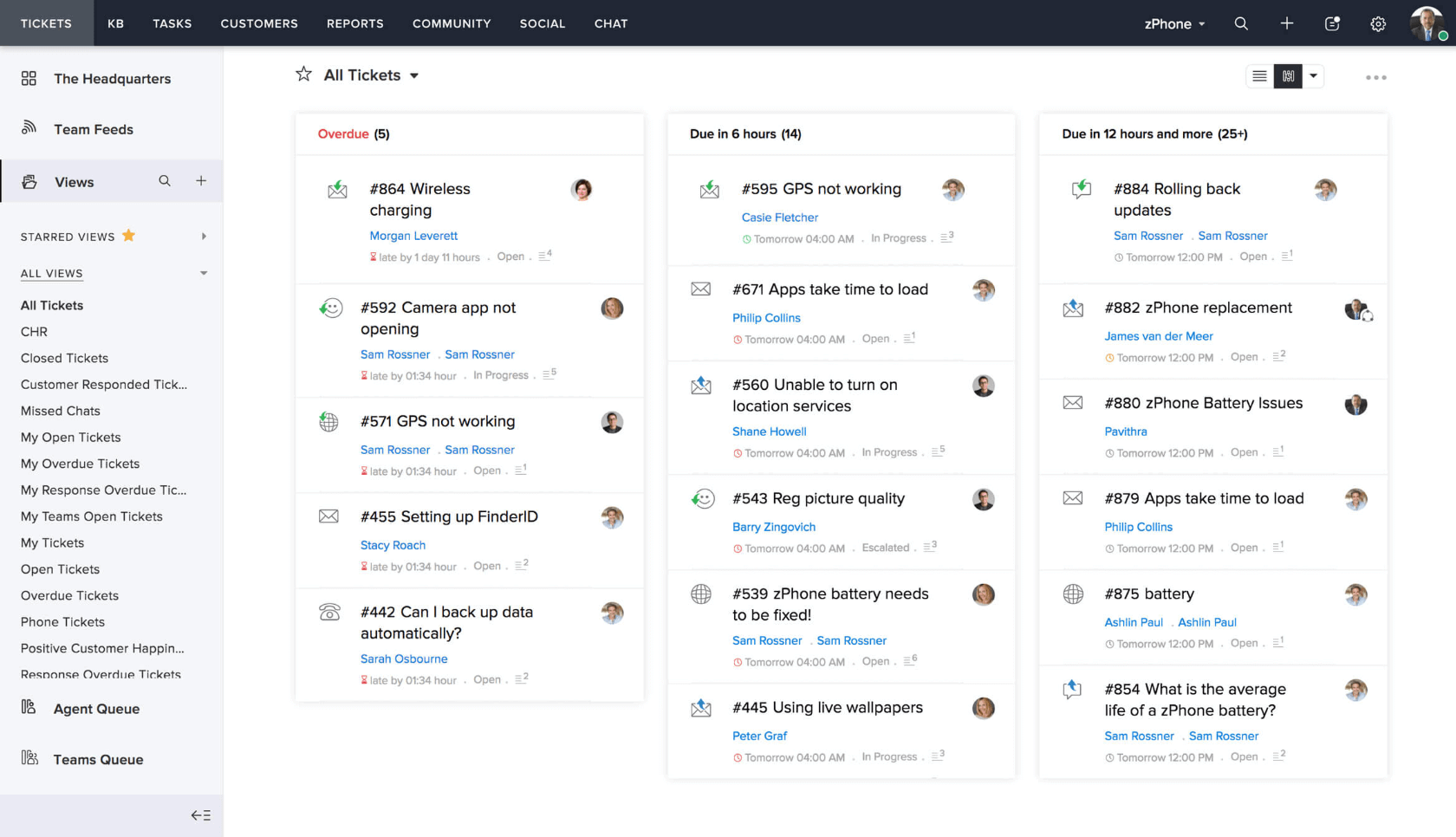
Key products:
- Zoho CRM is a unified platform that brings your sales, marketing, and support operations together. It’s known for its advanced scalability and customization options.
- Zoho Desk is a customer support software solution. Apart from a standard set of help desk features, it stands out with Zia—an AI assistant that can identify the sentiment behind each request. They also got Zoho Mail that is often used as a shared inbox for a small support teams.
- Zoho Books is an online accounting software for invoicing, expense tracking, bank reconciliation, inventory management, and more. The solution is affordable, highly customizable, and user-friendly.
- Zoho Analytics is an AI-powered business intelligence tool that helps businesses to collect, process, visualize, and analyze their data for informed decisions.
- Zoho Projects is a project management platform for planning, tracking, automating, and collaborating on tasks.
- Zoho Campaigns is an email marketing tool for planning, launching, and analyzing campaigns.
Like other software suite providers, Zoho allows you to purchase each solution separately. Alternatively, you can subscribe to Zoho One—a comprehensive suite providing access to Zoho's applications across various functions at a flat rate per user.
HubSpot
HubSpot provides a comprehensive portfolio of software solutions focused on various aspects of relationships with customers, including marketing, sales, customer service, and CRM.
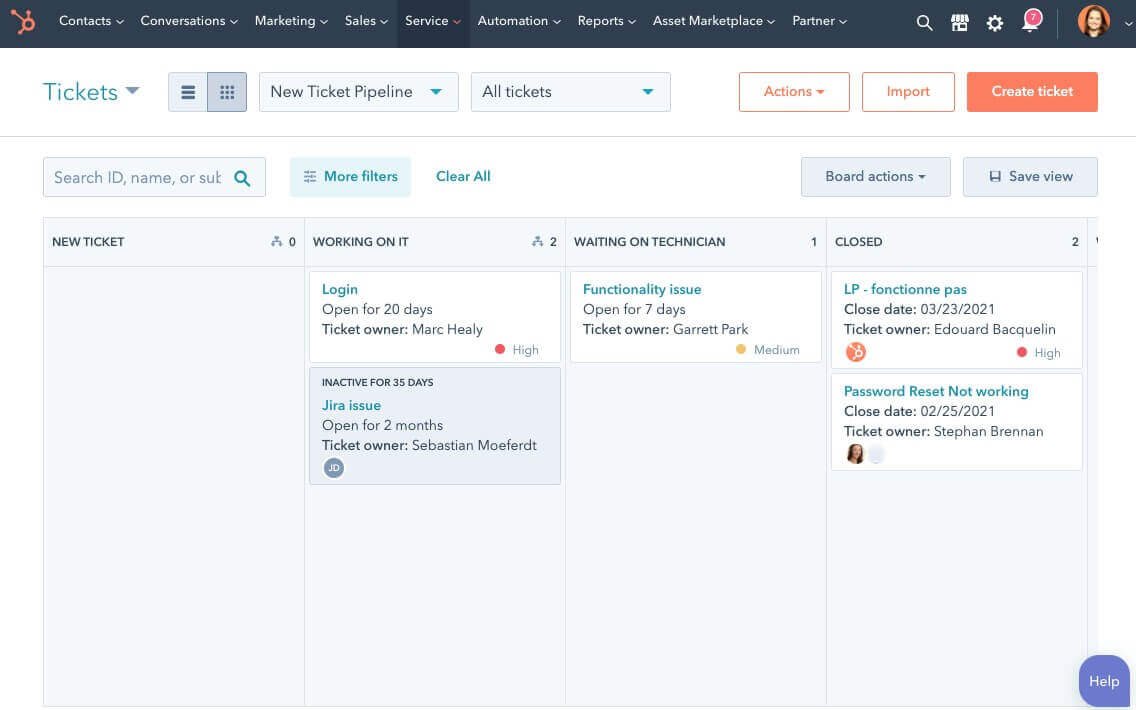
Key products:
- HubSpot CRM is a solution for managing contacts, deals, and sales pipelines. It’s HubSpot’s central product.
- Marketing Hub is an inbound marketing suite. It helps businesses to launch inbound marketing campaigns across channels at scale to attract and retain customers.
- Sales Hub: Tools for sales teams, including email tracking, meeting scheduling, deal tracking, automation, and sales analytics.
- Service Hub is a help desk management solution. It provides a comprehensive set of functionalities for ticketing, knowledge base management, live chat support, analytics, and more.
- CMS Hub is a content management solution that allows users to create, manage, and optimize website content.
- Operations Hub is a software solution that helps businesses connect multiple data sources (like apps) into a centralized database. It assists in data syncing, cleaning, and automation.
All the above solutions have free versions—all available through the Free Tools suite. This makes HubSpot suitable for small businesses and individual service providers without large teams and scalability needs.
Salesforce
Salesforce is known for popularizing the concept of accessing software over the internet. Their CRM platform was one of the earliest successful SaaS offerings. While remaining an undisputed leader in CRM, Salesforce has evolved into a comprehensive provider of software solutions spanning sales, customer service, marketing, analytics, and collaboration, catering to various facets of business operations.
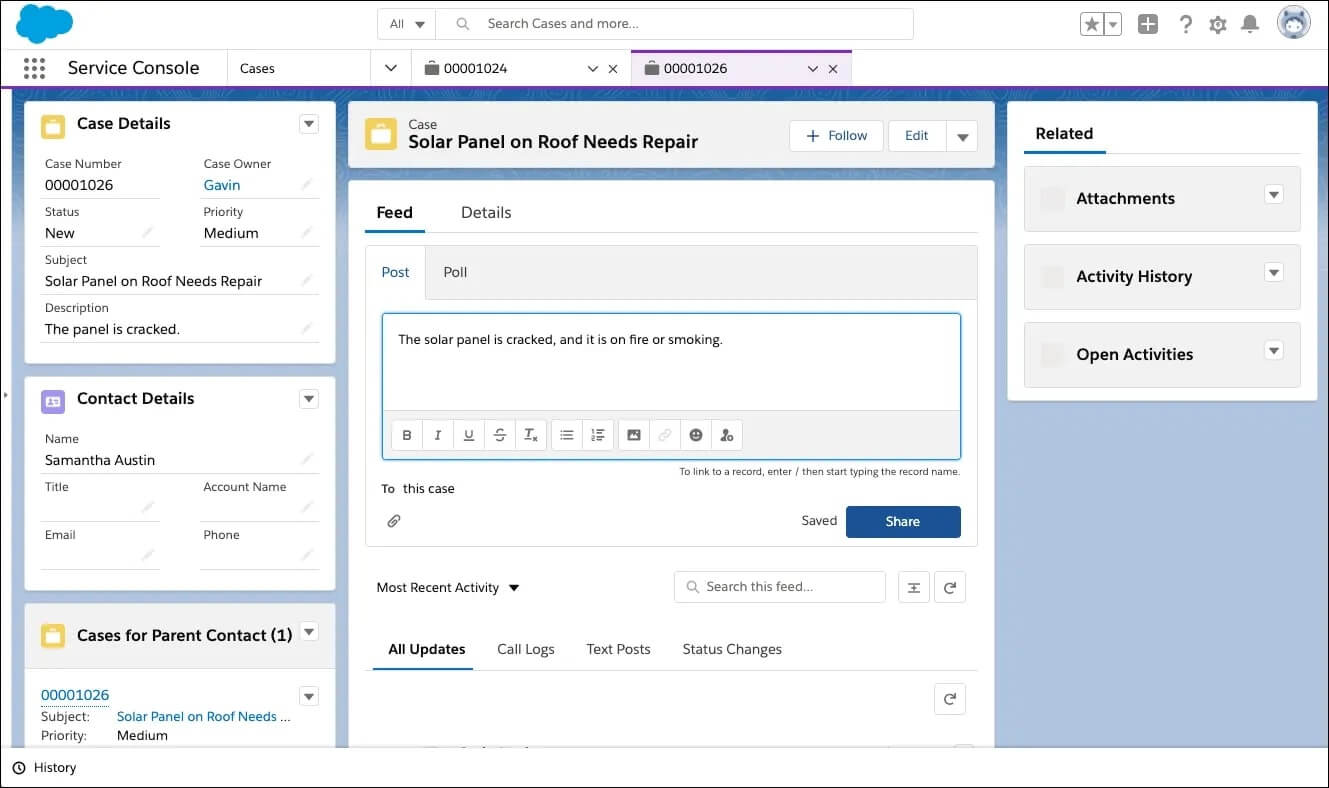
Key products:
- Sales Cloud is a CRM platform for both B2B and B2C segments and remains the key offering of Salesforce.
- Service Cloud is a customer service platform that helps companies resolve customer inquiries across multiple channels like phone, email, social media, and chat.
- Marketing Cloud is an integrated suite of software tools, that enables marketers to plan, implement, and analyze marketing campaigns across email, digital advertising, social media, and other channels.
- Commerce Cloud is a solution that enables businesses to set up online stores to streamline sales and provide a seamless shopping experience.
- Community Cloud is a platform for building branded online communities for connecting with customers, partners, and employees.
- Tableau (formerly Einstein Analytics) is an AI-powered analytics platform that enables data visualization and informed decision-making across various business operations.
Unlike HubSpot, its close competitor, Salesforce primarily targets large enterprises, with professional services providers, manufacturing, and financial institutions being the top users.
Atlassian
Atlassian offers a comprehensive suite of software solutions that tackles various aspects of software development team collaboration. It empowers users to work more efficiently, achieving better outcomes in their respective areas.

Key products:
- Jira Software is a software project management solution for planning, tracking, and releasing software.
- Jira Service Management is an IT service management (ITSM) solution.
- Confluence is a wiki-based content management tool for knowledge bases, product documentation, and intranets. It provides a centralized space where teams can create, organize, and share knowledge and project documentation in a centralized space.
- Bitbucket is a СI/CD tool and Git repository management solution for code collaboration and version control.
- Trello is a visual project management tool based on boards, lists, and cards, enabling flexible task management and team collaboration.
There are also enterprise-grade versions of Bitbucket, Jira Software, and Confluence—Bitbucket Data Center, Jira Software Data Center, and Confluence Data Center, respectively. They offer higher service availability, scalability, and performance, as well as enhanced security and administrative controls.
A Seamless Vendor Switch with a Powerful Data Migration Service
If you are considering the shift toward a unified suite, transferring data from existing help desk systems might seem daunting. But when it comes to your customer support data, Help Desk Migration has you covered.

Help Desk Migration is an automated data transfer tool with over 60,000 successful migrations. Whether you're migrating data to a new help desk platform or merging accounts into your chosen vendor's platform, our coding free solution ensures a seamless transfer of data from one vendor (or vendors) to the other. Our migration service maintains data structure integrity, ensures uninterrupted processes during migration, prioritizes data privacy, and offers dedicated support.
You have the flexibility to manage the entire migration process yourself through a user-friendly interface or opt for our Concierge migration for a hassle-free vendor switch experience. If you are ready to unlock the full potential of a unified software suite, you can test our migration tool or schedule a call to discuss your migration project.
Conclusion
Data migration to a unified software suite can be a strategic solution to combat the app sprawl prevalent in modern enterprise IT. By consolidating your processes into a multifunctional solution, you can streamline operations, enhance efficiency, reduce errors, bolster decision-making, and reduce your IT expenses.
Meanwhile, our Help Desk Migration will alleviate the daunting task of customer data migration, securely transferring tickets, contacts, and other related customer support information to a new location without interrupting your processes.
FAQs: Different Vendors vs Single Vendor
- Licensing fees (whether monthly or annual)
- Upgrades and feature updates (usually included, but sometimes offered as optional extras)
- Ongoing maintenance and support (depending on your support plan)
These costs vary based on your usage and customization needs, but we’re here to help you navigate them.
- Initial planning and assessment
- Data mapping and preparation
- Demo migration for testing
- Full migration
- Post-migration checks and training
This ensures a smooth transition with minimal disruption.
- Assessment and planning – Understanding your needs and setting a roadmap
- Data mapping – Aligning data between systems
- Demo migration – Testing to ensure everything is perfect
- Full migration – Moving all your data safely and accurately
- Post-migration checks – Ensuring everything’s running smoothly
- Run both the old and new systems side by side if needed
- Schedule migrations during off-peak hours to reduce disruptions
- Set a demo migration to catch any issues early on
- Receive ongoing support throughout the process to keep things moving smoothly
- Dedicated migration specialists to guide you through every step
- Live chat or email support for real-time help
- Post-migration support to help with any troubleshooting or questions
Access to helpful resources, FAQs, and training materials to make sure you’re set up for success.
- End-to-end encryption keeps your data safe during the transfer
- We follow strict security protocols and access control measures
- We meet industry standards like GDPR, HIPAA, and SOC 2, depending on your needs
- Regular audits ensure your data is always secure throughout the migration


